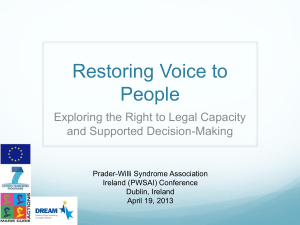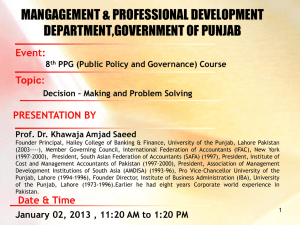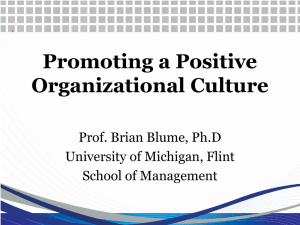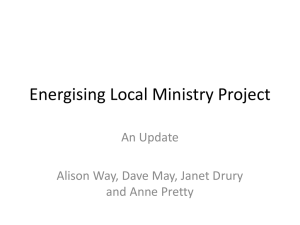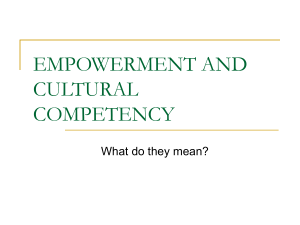- The National Deaneries Network
advertisement
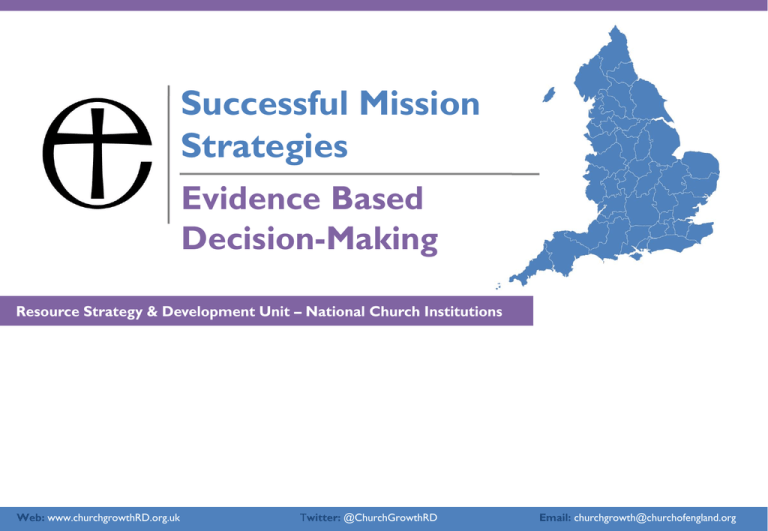
Successful Mission Strategies Evidence Based Decision-Making Resource Strategy & Development Unit – National Church Institutions Web: www.churchgrowthRD.org.uk Twitter: @ChurchGrowthRD Email: churchgrowth@churchofengland.org Why Plan? Successful Mission Strategies: Evidence Based Decision-Making ‘For which of you, desiring to build a tower, does not first sit down and count the cost, whether he has enough to complete it? Otherwise, when he has laid a foundation and is not able to finish, all who see it begin to mock him, saying, “This man began to build and was not able to finish”,’ (Luke 14:28-30). ‘Sluggards do not plough in season; so at harvest time they look but find nothing’ (Proverbs 20: 4). Resource Strategy & Development Unit – National Church Institutions Why a Strategy? • • Successful Mission Strategies: Evidence Based Decision-Making ‘..The term “strategy” should mean a cohesive response to an important challenge. Unlike a stand-alone decision or a goal, a strategy is a coherent set of analyses, concepts, policies, arguments, and actions that respond to a ... challenge’. ‘At the core, strategy is about focus, and most complex organisations don’t focus their resources. Instead, they pursue multiple goals at once, not concentrating enough resources to achieve a breakthrough in any of them.. ..Strategy is at least as much about what an organisation does not do as it is about what it does’. * Richard P Rumelt, Good Strategy, Bad Strategy, Profile Books, London, 2011. Resource Strategy & Development Unit – National Church Institutions Why a Strategy? Successful Mission Strategies: Evidence Based Decision-Making • We have a problem….. (or we may do if we don’t do anything) • We have an opportunity… (and if we don’t act on it, we may have a problem - or at best the opportunity may pass) Resource Strategy & Development Unit – National Church Institutions Successful Mission Strategies: Evidence Based Decision-Making Why a Church Strategy? • To advance our gospel vision • To exercise good stewardship Resource Strategy & Development Unit – National Church Institutions Why a Deanery Strategy? Successful Mission Strategies: Evidence Based Decision-Making • Decentralised decision-making is often best • Local knowledge, local resources • Decentralised decision-making cannot do everything: • Address need and opportunity • Share learning • Share resources and/or achieve critical mass • Co-ordinated action can enhance the ability to make change happen • There needs to be a balance between decentralised and coordinated action • But ... there needs to be a truly shared vision, goals - and strategy Resource Strategy & Development Unit – National Church Institutions Good Strategy = Successful Mission Strategies: Evidence Based Decision-Making • A diagnosis • • • • simplifies the complexity of reality identifies certain aspects of the situation as critical defines the domain of action Data information knowledge wisdom • A shared, guiding vision or policy • a sign-post, the broad direction forward • Coherent actions • Coordinated policies, resources and planned actions • Join up mission, ministry and money • Feasible Resource Strategy & Development Unit – National Church Institutions Developing Strategy Successful Mission Strategies: Evidence Based Decision-Making • Where are interventions most needed? What’s the data and evidence telling us? What’s our guiding policy? • What interventions will be most fruitful? What’s the evidence telling us? • What opportunities to intervene do we have? • Focus effort and resources - “better to do a few things well” The essence of a plan should answer “Who, what, where, when”? • How will we know if we’re doing well? Milestones, measurement Resource Strategy & Development Unit – National Church Institutions Embedding Strategy Successful Mission Strategies: Evidence Based Decision-Making Resource Strategy & Development Unit – National Church Institutions Developing Strategy Successful Mission Strategies: Evidence Based Decision-Making Church Growth Research (…some of the evidence) Resource Strategy & Development Unit – National Church Institutions Youth & Children… Successful Mission Strategies: Evidence Based Decision-Making • The Church is declining due to its failure to attract and retain children & young people Adult leavers and joiners balance out 48% of churches have <5 under 16’s Ages 14 and 18-25 are key points where we ‘leak’ Only 36% of Anglicans think it important for their children to learn the faith • Churches employing a Children’s / Youth Worker are twice as likely to be growing as those which do not. • • • • Resource Strategy & Development Unit – National Church Institutions Successful Mission Strategies: Evidence Based Decision-Making Fresh Expressions of Church… • There is significant growth through Fresh Expressions of Church • Around 21,000 attending in 10 dioceses surveyed (equivalent of an additional medium sized diocese) • 52% are led by lay people, over 40% ‘lay-lay’ (no status or training) • For every 1 person sent we get 2.6 more people joining • 25% existing Christians, 35% de-churched, 40% non-churched • 66% carry on growing or retain growth. Resource Strategy & Development Unit – National Church Institutions Intentionality… Successful Mission Strategies: Evidence Based Decision-Making • Intentionality is crucial • Prioritizing growth significantly correlated with actual growth • Growth is more likely where churches are clear about who they are and what they do: in terms of style, tradition and outreach. • Having a clear mission and purpose is important: Of those who reported this 64% had grown compared with only 26% of those that did not. • Vitality comes with reflection and choice: “churches cannot soar on auto-pilot” Resource Strategy & Development Unit – National Church Institutions Leadership… Successful Mission Strategies: Evidence Based Decision-Making • Good leadership from the clergy is important • Clergy need to motivate, envision and innovate • Of those clergy who scored highly for ‘motivating’ around two thirds reported growth compared with less than 10% of those who were ‘below average on that quality • Results were similar for those who scored highly for envisioning • They need to look outwards, set vision and engage with proactively engage with newcomers • Empathizing and persisting were associated with decline • Clergy need to drive vision and change Resource Strategy & Development Unit – National Church Institutions The laity… Successful Mission Strategies: Evidence Based Decision-Making • The laity need to be willing and involved • Good lay leadership and rotation of key lay roles are associated with growth • A willingness to experience change is important – ‘new people disrupting a cosy club’ • Where the laity are discipled - (e.g. through nurture courses) and there is a strong emphasis on preparing the laity to be Christians in their daily lives - there is more likely to be growth • Growth is often the result of the laity inviting family and friends Resource Strategy & Development Unit – National Church Institutions Using data to understand the issues Developing Strategy (Using Data) Successful Mission Strategies: Evidence Based Decision-Making Resource Strategy & Development Unit – National Church Institutions Mission and Finance Strength An analysis has been made of the mission and finance strength of the parishes within the diocese, by placing them within a quadrant diagram with mission strength on the x-axis and financial strength on the y-axis. Financial strength is calculated by reference to the unrestricted income of a parish and whether or not it exceeds their total ministry costs and training costs. Mission strength is calculated by looking at the annual growth or decline in the average weekly attendance of a parish over the last 5 years. This assumes that over a long enough period, a church which is strong in mission terms will experience attendance growth. Whilst this objective analysis provides a firm and consistent basis for decision-making, it needs to be supplemented by analysis of other data (see later in the report). Successful Mission Strategies: Evidence Based Decision-Making Resource Strategy & Development Unit – National Church Institutions Mission and Finance Strength The diagram shows the distribution of the parishes in the diocese, according to their mission and financial strength. The largest concentration of parishes can be seen in the bottom left quadrant, i.e. parishes that are declining in size and are also financially struggling. 16% of parishes are in the opposite quadrant where there has been growth and the parish is financially strong. Successful Mission Strategies: Evidence Based Decision-Making Resource Strategy & Development Unit – National Church Institutions Mission and Finance Strength This diagram again shows parishes according to their mission and financial strength but this time the size of each ‘bubble’ on the graph represents the parish’s average weekly attendance. This shows that, although the majority of parishes are showing decline (see previous diagram), the larger ones tend to be showing growth. A third of attendees are in growing and financially strong parishes compared to 20% of attendees within declining and financially struggling parishes. Successful Mission Strategies: Evidence Based Decision-Making Resource Strategy & Development Unit – National Church Institutions Adding Other Data Resourcing Church Growth: Evidence Based Decision-Making The backing data for the analysis of mission and financial strength, plus other relevant information for each parish, can help build a more complete picture of the strength (or weakness) of existing ministry, and the opportunities for change. For example, analysis of a parish’s attendance per population will give some measure of the church’s impact on its local neighbourhood. Below is a list of some of the measures which are used in the attached analysis or ones which the diocesan leadership team itself may wish to add. Factor Membership Measure 5 year AWA change, Electoral Roll Ministry Costs (£) Full cost of parish ministry to the diocese Parish Income (£) Unrestricted + restricted Demographics Congregational Age Profile Ministerial Provision (lay and ordained) Contextual Leadership and Direction Population, IMD, age profile of population Survey of congregation Number of ministers (age and length of tenure) Other denominations, church schools Quality of Mission Action Plan (and quality of leadership?) Resource Strategy & Development Unit – National Church Institutions It is desirable to get as complete picture as possible of the context in which a particular church undertakes its ministry. At the same time, the temptation may be to add more and more data before any assessment can really be made. This is likely to lead to ‘analysis paralysis’: the loss of sharp focus to guide any decision-making. Interventions Successful Mission Strategies: Evidence Based Decision-Making Employ a youth worker? Additional Clergy? Focus on growth Fresh Expression? Change of leadership? Turnaround team? Invest in growth Appoint Pioneer Minister? Resource Strategy & Development Unit – National Church Institutions Church plant? Continue sustainable growth Additional staff? Develop stewardship? Achieve sustainable growth Train lay leaders? Developing Strategy Successful Mission Strategies: Evidence Based Decision-Making • What are the big opportunities facing your deanery this year for developing the Church’s mission, and spiritual and numerical growth? • What information should inform the way the opportunities are addressed? • What are the priorities? • If sufficient information is not available, how can you change that position? • Is your deanery mission action plan a good strategy, or is it… Resource Strategy & Development Unit – National Church Institutions Bad Strategy = • Bad strategy is the active avoidance of the hard work of crafting a good strategy…with these hallmarks: • • • • Fluff. “... a form of gibberish masquerading as strategic concepts or arguments … words that are inflated and unnecessarily abstruse to create the illusion of high-level thinking”. Failure to face the challenge. Bad strategy fails to recognise or define the challenge. If you cannot define the challenge how do you know you are tackling the right things? Mistaking goals for strategy. Many bad strategies are just “statements of desire” rather than plans for overcoming obstacles. Bad strategic objectives. Strategic objectives are ‘bad’ when they fail to address critical issues and/or when they are impracticable - or when there are too many of them! Successful Mission Strategies: Evidence Based Decision-Making Resource Strategy & Development Unit – National Church Institutions

